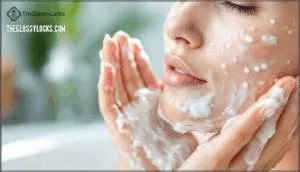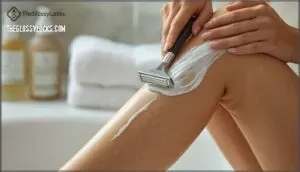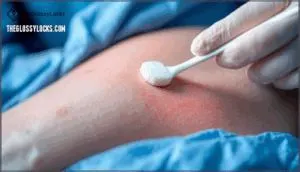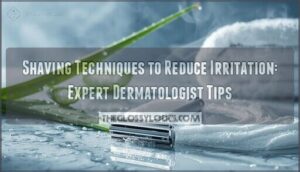This site is supported by our readers. We may earn a commission, at no cost to you, if you purchase through links.
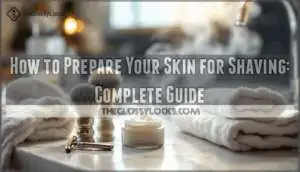
Proper skin preparation removes dead cells blocking hair growth, strengthens your skin’s barrier, and reduces friction that causes irritation. The difference isn’t subtle: exfoliation alone can smooth your shave by up to 30% while cutting ingrown hair incidence by 38%.
Your skin doesn’t need complicated routines—it needs the right sequence of simple steps that work together. What follows is exactly how to prepare your skin so every shave feels like it was done by a professional.
Table Of Contents
Key Takeaways
- Proper skin preparation—exfoliation, cleansing, and hydration—reduces ingrown hairs by 38% and smooths your shave by up to 30%, making it the foundation for irritation-free shaving.
- Blade sharpness and shaving direction matter as much as prep: dull blades increase razor bumps by 70%, while shaving with the grain (not against it) cuts ingrown hair risk in half.
- Post-shave moisturization within minutes restores your skin barrier and prevents infection; glycerin-based formulas boost moisture retention by 30% while alcohol-free options cut redness by 50%.
- For surgical hair removal, depilatory creams outperform razors by producing skin injuries in only 4% of cases versus 29% with shaving, directly lowering surgical site infection rates.
Why Skin Preparation Matters Before Shaving
Getting a close, comfortable shave starts well before the razor touches your skin. When you prepare your skin properly, you’re setting yourself up for better results and fewer problems down the line.
Here’s what you need to know about why this step matters so much.
Role of Exfoliation in a Closer Shave
When dead skin cells pile up on your skin’s surface, they act like tiny roadblocks for your razor blade. Exfoliation clears these away, which smooths your shaving experience by up to 30%. You’ll need fewer strokes to get that close shave you want.
A preshave scrub using gentle exfoliants removes keratinized debris and lifts sebum from follicles, letting your razor glide more efficiently and reducing friction. Exfoliate two to three times weekly—chemical exfoliants work best for sensitive skin, while mechanical scrubs suit oiler types.
Exfoliating also helps to prevent ingrown hair formation. This timing maximizes product penetration of your shaving cream while minimizing irritation. The result: smoother skin with better razor control and enhanced hydration retention.
Preventing Ingrown Hairs and Razor Burn
Ingrown hairs and razor burn stem from the same root cause: hair getting trapped beneath your skin’s surface. When you skip proper exfoliation techniques and razor hygiene, you’re setting yourself up for irritation.
Here’s what makes the difference:
- Exfoliation removes dead cells that block hair from exiting cleanly, reducing ingrown hair incidence by 38%
- Blade sharpness matters—replace your razor every 5–7 uses to cut hair cleanly, not tear it
- Shaving direction counts—going with the grain lowers ingrown hairs by 45% versus against the grain
- Post-shave hydration seals the deal—moisturizing immediately after reduces water loss by 40% and calms inflammation
- Razor hygiene prevents infection—cleaning with isopropyl alcohol between uses drops bacterial load by 94%
When you combine proper shave prep with these techniques, you’re not just avoiding problems. You’re actively protecting your skin. You can also use salicylic acid products after shaving to improve razor bumps.
Improving Overall Skin Health Through Prep
Proper skin preparation does more than prevent irritation—it strengthens your skin’s foundation. When you exfoliate, cleanse, and hydrate before shaving, you’re supporting barrier function and reducing inflammation that normally follows blade contact. This consistent care improves moisture retention and promotes long-term conditioning of your skin.
Proper skin preparation strengthens your barrier, reduces inflammation, and promotes lasting skin resilience through consistent cleansing, exfoliation, and hydration
| Benefit | How It Works | Result |
|---|---|---|
| Barrier Function | Pre-shave hydration protects your skin’s natural lipid layer | Less water loss and irritation post-shave |
| Inflammation Reduction | Exfoliation removes dead cells that trigger reactive swelling | Calmer, less red skin within hours |
| Microbiome Balance | Gentle cleansing preserves beneficial bacteria | Stronger natural defense against infection |
Your shave prep routine isn’t just about today’s shave—it’s an investment in healthier skin months from now.
Step-by-Step Skin Preparation Techniques
Getting your skin ready for shaving takes a little preparation, but it makes a real difference in how close and comfortable your shave feels. The good news is that the process is straightforward—it’s really just three essential steps that work together to protect your skin and give your razor the best possible surface to work with.
Let’s walk through exactly how to do each one.
Cleansing The Skin to Remove Oil and Bacteria
Your skin harbors up to a million bacteria per square centimeter—and that’s before shaving. Cleansing removes oils and pathogenic bacteria that can clog your razor and trigger irritation.
Use a mild, low-pH cleanser (4.5–5.5) to wash away sebum without stripping your skin barrier. Antimicrobial cleansers reduce bacterial load by up to 90% immediately, though recolonization begins within hours.
This pre-shave step sets the foundation for a smoother shave, healthier skin microbiome, and fewer complications like infection or razor bumps.
Proper Exfoliation Methods and Frequency
Exfoliation works in two ways: mechanical methods like scrubs physically slough away dead cells, while chemical exfoliants using salicylic acid dissolve them without abrasion. Your skin type determines frequency—oily skin tolerates three to four times weekly, combination skin two to three times, and sensitive skin once weekly or less.
Pre-shave exfoliation removes keratinized buildup, exposing hair shafts for closer cuts and smoother glide. This ingrown hair prevention is especially valuable for curly hair types.
Avoid over-exfoliation; it damages your skin barrier and increases irritation risk. Pair exfoliation with moisturization to maintain skin integrity in your shaving routine.
Hydrating Skin and Hair Before Shaving
After exfoliation, your skin’s ready for hydration—the final prep step before shaving. Water temperature matters here: warm water opens pores and softens facial hair, making it easier for your razor to glide.
Here’s what works best:
- Apply warm water or take a warm shower 2–3 minutes before shaving to hydrate both skin and stubble
- Use a hydrating shave cream with ingredients like hyaluronic acid or aloe vera for best moisture and blade glide
- Consider a pre-shave product or oil to create a protective layer, especially if you have sensitive skin
Properly hydrated hair becomes softer and more pliable, reducing tugging and irritation. This timing—applying moisture right before shaving—is critical because it minimizes friction between blade and skin, lowering your risk of razor burn and nicks. Well-hydrated skin also heals faster from any minor damage.
Choosing The Right Shaving Products
The right shaving products make all the difference between a smooth, comfortable shave and one that leaves your skin irritated and uncomfortable. Your choice of cream, gel, and razor directly affects how well you protect your skin barrier and prevent problems like ingrown hairs and razor burn.
Let’s look at what actually works and how to pick what’s best for your skin.
Benefits of Shave Creams and Gels
Think of shave cream as your skin’s bodyguard during shaving. When you apply it, you’re creating a protective barrier that does real work: it hydrates your beard hairs so they absorb up to 30% more water, making them softer and easier to cut. That hydration reduces cutting force by 40% compared to dry shaving.
The cream also slashes friction between blade and skin by up to 60%, which means fewer nicks—clinical studies show just 5 per session versus 12 without product. This friction reduction directly cuts razor burn and redness by 35-42%. Quality gels go further: transparent formulas let you see exactly where you’re shaving, improving precision by 18%.
After you’re done, the moisturizing base keeps your skin barrier intact, maintaining 90% of its baseline integrity while soothing inflammation. Post-shave hydration stays 33% higher when you’ve used cream, and that protective film limits water loss by 28%. Bottom line: shave cream isn’t luxury—it’s a skincare strategy that prevents irritation before it starts.
Importance of Natural Exfoliating Ingredients
When shopping for pre-shave products, natural exfoliating ingredients deserve real consideration. Enzyme exfoliants from papaya and pineapple remove up to 40% of dead skin buildup while maintaining your skin’s pH—something synthetic acids struggle with.
Botanical benefits shine here: they cause 35% less redness than synthetic counterparts and carry under 1.5% sensitization risk versus 6–8% for mechanical scrubs. Natural vs synthetic isn’t just marketing—clinical data shows fruit enzymes keep hydration 15% higher post-exfoliation.
The safety profile matters too. Plant-derived exfoliants support your barrier recovery within 48 hours through ceramide enhancement. Market trends reflect what dermatologists see: consumers increasingly prefer enzyme formulations because they deliver efficacy without the irritation tax.
For skin preparation before shaving, these gentler options give you a closer shave with measurably less damage.
Selecting Razors for Sensitive Skin
Your razor choice shapes everything about your shave. If you’re dealing with sensitive skin, blade count matters most. Two-blade safety razors cut hair cleanly at skin level, reducing ingrown hairs and razor bumps compared to four-blade systems that create excess passes and friction. Single-blade designs produce 40% less redness than cartridge razors.
For those preferring electric shavers, cooling technology and proper technique lower irritation to 49% versus 78% with manual blades. Lubrication technology—dual polymer strips and moisture-activated formulas—reduces friction and maintains hydration 15% better post-shave. Stainless steel or chrome-plated blades stay sharp longer, preventing tugging.
Consider safety razors too: they’re gentler, cost 80% less per blade, and eliminate shaving waste while delivering excellent results for sensitive skin.
Reducing Skin Irritation and Complications
Shaving irritation and razor bumps don’t have to be inevitable. When you take the right steps, you can dramatically reduce redness, prevent infection, and keep your skin calm and healthy after shaving.
Here’s what actually works to protect your skin during and after the process.
Minimizing Razor Bumps and Redness
When razor bumps appear, you’re seeing your body’s inflammatory response to hair trauma. That response hinges on three controllable factors: blade sharpness, shaving direction, and pre-shave preparation.
Dull blades create jagged hair ends that penetrate your skin rather than cut cleanly—multiplying pseudofolliculitis risk by up to 70%. Sharp blades cut closer to the skin surface, minimizing irritation. Shaving with the grain, not against it, reduces transfollicular penetration by 50–75%.
Before shaving, exfoliate with salicylic acid or lactic acid. This lifts ingrown hairs above the skin line and reduces razor bumps by 60% in sensitive individuals. Combining exfoliation with hydration—warm water softens hair and reduces inflammation markers by 25–30%—creates your defense against redness. Product ingredients matter too: chamomile and aloe reduce post-shave burning by 40%, while glycerin and allantoin speed recovery.
Post-shave Moisturization and Care
Your skin needs moisture after shaving. That warm blade opens your pores and strips away natural oils, leaving your barrier compromised. A good postshave balm or lotion restores hydration fast.
Glycerin-based formulas boost moisture retention by 30%, while alcohol-free options cut redness by 50% compared to traditional aftershaves. Apply within minutes of shaving. Ingredients like aloe vera and witch hazel accelerate healing by 1.4 times and lower inflammation by 40–60%.
Consistent moisturization also prevents erythema recurrence across multiple shaves, keeping your skin resilient and comfortable.
Preventing Infection and Promoting Healing
Your skin’s barrier is now vulnerable—those tiny cuts from the blade create entry points for bacteria. That’s why the next step matters as much as the prep itself.
Apply a mild antiseptic or natural aftershave with jojoba or coconut oil within minutes. These ingredients reduce inflammation and prevent folliculitis while maintaining moisture balance. Avoid alcohol-based products; they kill bacteria but damage your healing barrier.
Consistent moisturization with glycerin-based formulas repairs barrier function within an hour, decreasing infection risk and promoting faster wound healing while keeping your skin resilient between shaves.
Skin Preparation for Surgical Hair Removal
If you’re having surgery, skin preparation goes beyond the usual shaving routine—it’s about preventing infection at the surgical site. Your medical team will guide you through specific antisepsis protocols designed to reduce bacteria on your skin before the procedure.
We’ll walk you through the key methods and what the research shows about their effectiveness.
Preoperative Skin Antisepsis Protocols
Before surgery, your skin needs more than routine cleansing—it requires antiseptic preparation to prevent infection. The World Health Organization and CDC recommend alcohol-based chlorhexidine gluconate (CHG) solutions, which reduce surgical site infections by 25–40% compared to iodine-based alternatives.
CHG works by disrupting bacterial cell membranes and maintains protective activity for up to six hours post-application.
Apply the antiseptic in concentric circles from the incision center outward, then allow it to dry completely before draping. This standardized guideline compliance ensures best skin antisepsis effectiveness and surgical outcomes.
Comparing Shaving and Depilatory Creams
When hair removal is necessary before surgery, you’ve got two main options: shaving or depilatory creams. Here’s the clinical reality: studies show skin injuries occurred in 29% of patients who shaved versus only 4% using depilatory creams. That’s because razors create microabrasions that increase bacterial colonization risk.
Depilatory creams work differently—they break down hair keratin chemically, removing hair below the skin surface rather than just cutting it. This means smoother results lasting up to a week, compared to 24–48 hours with shaving. The trade-off? Application takes 5–10 minutes versus near-instant shaving.
Cost-wise, quality depilatory creams run $5–$15 per tube, similar to razor expenses. For surgical prep on difficult-to-access areas like the groin or underarms, creams offer real advantages. They’re gentler on sensitive skin and work evenly across curved surfaces where nicks happen easily. Just avoid them on broken or inflamed skin.
The evidence is clear: when hair removal is needed preoperatively, depilatory creams considerably outperform shaving for reducing skin irritation and maintaining surgical site integrity.
Impact on Surgical Site Infection Rates
The hair removal method you choose directly shapes your surgical site infection risk. Manual shaving produces infection rates around 2.5% to 8.8%, while electrical clipping drops that to 1.4%—a significant difference. Timing matters too: infections nearly double when more than 12 hours pass between hair removal and surgery.
Here’s what the evidence shows: combining immediate preoperative clipping with alcohol-based antiseptic skin prep achieves the lowest infection rates, sometimes reducing wound infections by 60% compared to night-before shaving. Depilatory creams also outperform razors by avoiding microabrasions that harbor bacteria.
The bottom line is simple—your preoperative skin preparation strategy directly influences surgical outcomes.
Frequently Asked Questions (FAQs)
How long should I wait after exfoliating before shaving?
You might think exfoliation’s benefits mean shaving immediately after, but wait—your skin needs time. Most dermatologists recommend waiting 24 hours after exfoliation before shaving.
This allows your skin pH to recover, sensitivity to peak and then decline, and your barrier function to restore. If you must shave sooner, wait at least 6-8 hours to reduce post-shave irritation and razor burn risk.
Can I use the same razor for multiple shaving sessions?
Yes, but with important limits. Razor blades generally become dull after 5–7 shaves due to microscopic damage—tiny cracks and chips form each time hair contacts the steel edge.
This microscopic damage reduces shaving efficiency and increases friction, leading to tugging, irritation, and bacterial buildup on the blade. Reusing a dull blade thwarts your skin preparation efforts and proper shaving technique.
Replace blades regularly to maintain clean cuts and protect your skin from unnecessary trauma.
Whats the best way to store shaving products?
Store shaving cream in glass or BPA-free plastic containers in cool, dry places below 25°C. Sealed, airtight containers prevent evaporation and extend shelf life by six months.
Keep containers on non-slip bases away from humidity and direct sunlight to maintain product potency and hygiene.
Should men and women prep skin differently for shaving?
Your skin differs from women’s in ways that shape how you should prep. Men’s skin is thicker with denser collagen and higher sebum production, requiring more thorough exfoliation and hydration.
You also have thicker hair shafts and higher facial growth rates, so stronger shaving cream and consistent preshave preparation prevent irritation better than lighter routines designed for finer hair.
How do I know if my skin is over-exfoliated?
Over-exfoliation shows up as persistent redness, burning sensations, and flaky patches—your skin’s barrier is compromised. These symptoms indicate that your skin’s protective lipid layer has been damaged, leading to increased transepidermal water loss and heightened vulnerability to irritation and infection.
Watch for increased sensitivity, tightness, and dryness. These sensory symptoms signal inflammation and pH changes, which are key factors in the breakdown of your skin’s protective functions.
Conclusion
You might assume that proper skin preparation demands expensive products or hours of commitment—but the reality is simpler. The right sequence of cleansing, exfoliation, and hydration transforms your shave without complexity.
When you prioritize the importance of skin preparation for shaving, you’re not just preventing bumps and irritation; you’re giving your skin what it genuinely needs to thrive. Start tonight, and notice the difference by tomorrow morning.
- https://cdn.who.int/media/docs/default-source/integrated-health-services-(ihs)/ssi/fact-sheet-bathing-web.pdf?sfvrsn=836ad2b0_2
- https://www.ast.org/uploadedfiles/main_site/content/about_us/standard_skin_prep.pdf
- https://www.sciencedirect.com/science/article/pii/S1877056818303062
- https://multimedia.3m.com/mws/media/880314O/3m-infection-prevention-solutions.pdf
- https://pmc.ncbi.nlm.nih.gov/articles/PMC8406791/

